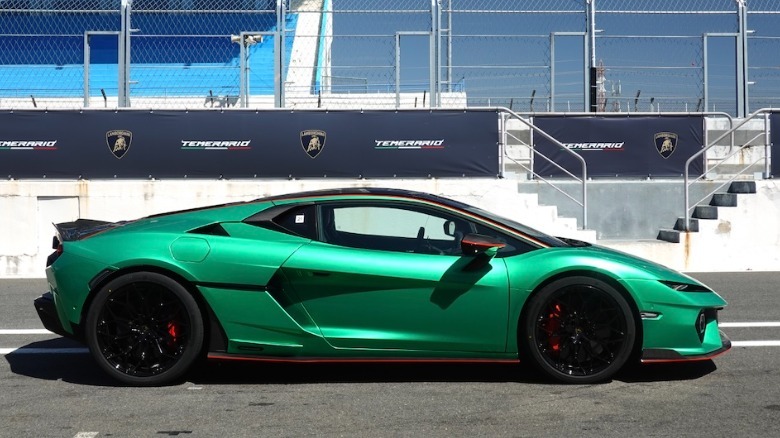Lamborghini Temerario First Drive: $385K for a Dose of Drama

A New Era of Supercars: The Lamborghini Temerario
In the world of high-performance vehicles, one question always comes up: "What's your favorite car?" It’s a simple query, but it requires more context. For me, I mostly own old Mitsubishi trucks, an obsession that most people might not fully understand. However, when it comes to modern supercars, my answer is clear—Lamborghini's Huracán Sterrato. While cars like the McLaren 750S can outperform on a racetrack, the Ferrari 296 GTB looks better, and the Corvette ZR1 offers more power for half the price, nothing quite matches the thrill of a naturally aspirated V10 in a mid-engined chassis with lifted suspension.
But this year, the Huracán's successor arrived, and it brought stats that are truly mind-boggling. The new Lamborghini Temerario features a hybrid powertrain combining three electric motors with a V8 engine equipped with two 70-millimeter turbos. This setup allows the engine to rev up to 10,250 RPM, which is unheard of for a turbocharged engine. The Temerario also adds about 20% more weight compared to the Huracán, thanks to the hybrid system and a larger design with improved comfort features.
This made a journey to Estoril Circuit in Portugal all the more intriguing. I needed to know if anything could ever replace the Sterrato at the top of my absurd list.
Technical Breakdown of the Temerario
The Temerario’s powerplant is a marvel of engineering. The rear e-motor mounts on the crankshaft rather than inside the DCT, as seen in the Revuelto. This presented additional challenges while targeting 10,000 RPM. The huge turbos take time to spool up, so the Temerario needed help filling torque delivery gaps. Despite these challenges, the Temerario can rev up to 10,250 RPM in launch mode.
Another interesting detail is that the Temerario’s engine uses the same alloy for cylinder heads as Ducati’s MotoGP engines, built in the same foundry in Italy. The engine is maintenance-free, meaning no prescribed service intervals for valve clearance checks.
Performance on the Track
Out on the track at Estoril, the Temerario delivered boundless torque at any RPM, revving effortlessly to the point that I sometimes forgot to shift. The engine’s smooth power delivery mimics a naturally aspirated engine, giving the impression that the Temerario has gained zero weight compared to the Huracán. The steering attempts to mask the mass, offering minimal resistance to turn-in that borders on disconcerting at first.
Despite the light steering, the Temerario never lacks precision. Quick corrections and flicks of countersteer never get tiring. I easily whipped around to catch little slides coming out of corners, in quintessential rally racing style. On my first stint, I set a personal record of 300 kph (186 mph), which was five mph faster than I hit at COTA in a ZR1.
However, the Temerario is not light. With a claimed dry weight of 3,725 pounds, it likely weighs over 4,000 pounds when full of fluids and a journalist trying hard to hustle around a racetrack. Fortunately, Lamborghini offers a lightweighting package called Alleggerita, which swaps on carbon-fiber wherever possible, increasing downforce and aerodynamic efficiency.
Improved Tires and Performance
From my second stint on, I drove an Alleggerita. The most noticeable improvement was the tires. Steering communicativeness took a significant step up, still light but infinitely more granular. The titanium muffler turned the V8's soundtrack up a few notches, though many owners will want to tear out the particulate filter immediately.
Despite the improvements, I struggled to keep up with my lead-follow instructor. He extended the gap coming out of each corner and especially on the straight. Later, I realized I had been in Recharge mode the whole time, which caps peak power in the name of regen.
Drift Mode and More
My lead-follow driver then climbed into the passenger seat to coach me through the use of a new-for-Lambo drift mode. Using a dedicated button and knobs on the steering wheel, Lambo’s version of adjustable traction control prioritizes rear-wheel power delivery while using the front two e-motors to better hold slides via torque vectoring. I managed a few solid drifts, just in time to try Launch Control.
All the modes and functions are intuitive. Push the button, step on the brake and gas pedals simultaneously, watch the turbos spool up, and side-step the brake. The Temerario delivers the kind of whiplash typically experienced only in the most hardcore electric vehicles.
Final Thoughts on the Temerario
Mohr explained that the Temerario’s electric motors never disconnect, making the top end even more impressive. This kind of turbocharged performance, spanning a rev range wider than just about anything that’s not a Ducati MotoGP bike, might make the Temerario more potent even than the Revuelto.
While I now need to rethink the Sterrato quandary, given the ability to hoon about in childlike glee on asphalt, the prospect of actually living with a Temerario benefits from other carryovers introduced by the Revuelto, especially improvements to interior ergonomics and Citta mode for silent early morning startups.
Plus, the Temerario can soften up the adjustable dampers for cruising, and Lambo will even offer ventilated seats now, while a charge port on the right flank leaves plenty of space for groceries or luggage.
On a more serious note, Mohr reiterated that there are no plans to create a Sterrato version of the Temerario. Despite my eternal optimism, I believed him. Part of the decision stems from leaving the past behind to open up the possibility of entirely new unexpecteds in the future.
With the Temerario, Lamborghini's hybrid era is now fully underway. More variants will certainly arrive, and given the industry backtracking on full electrification, a solid chance exists that the Temerario’s lifespan might well extend further into the foreseeable future. And I, for one, am all for it.